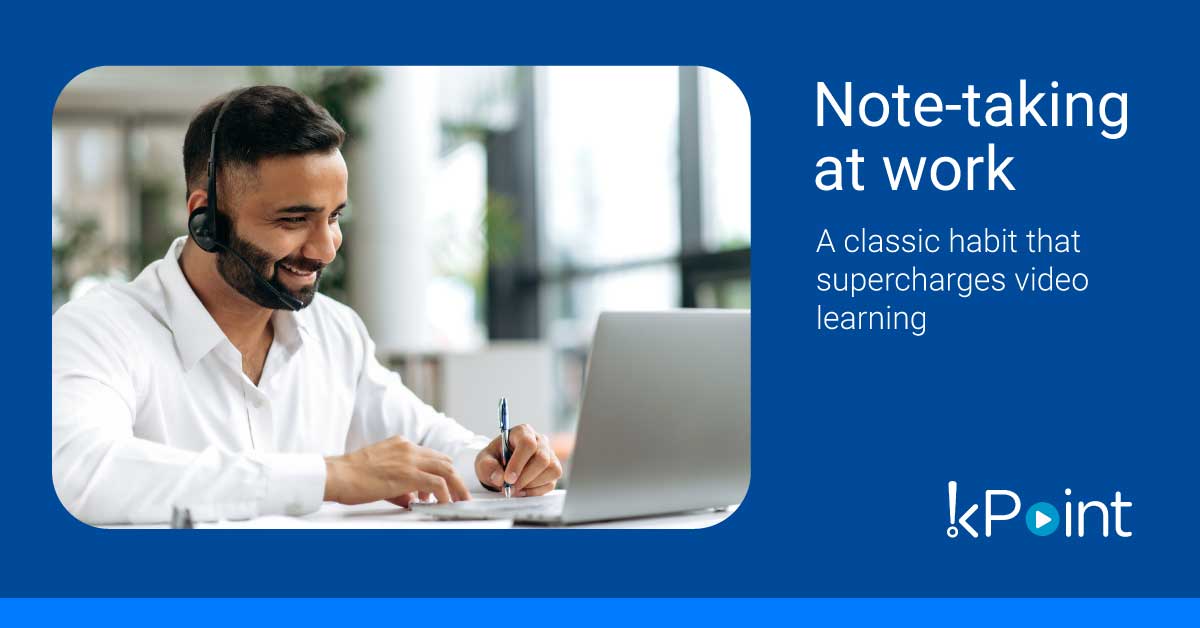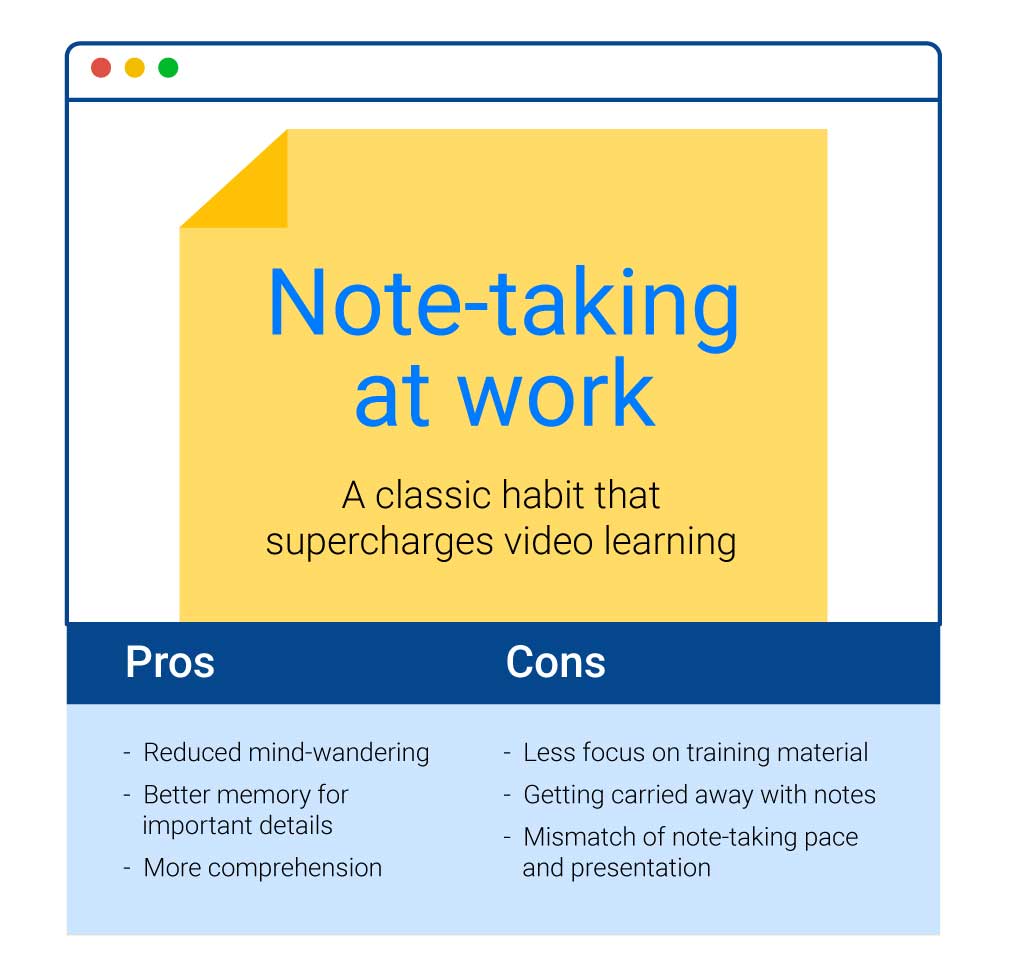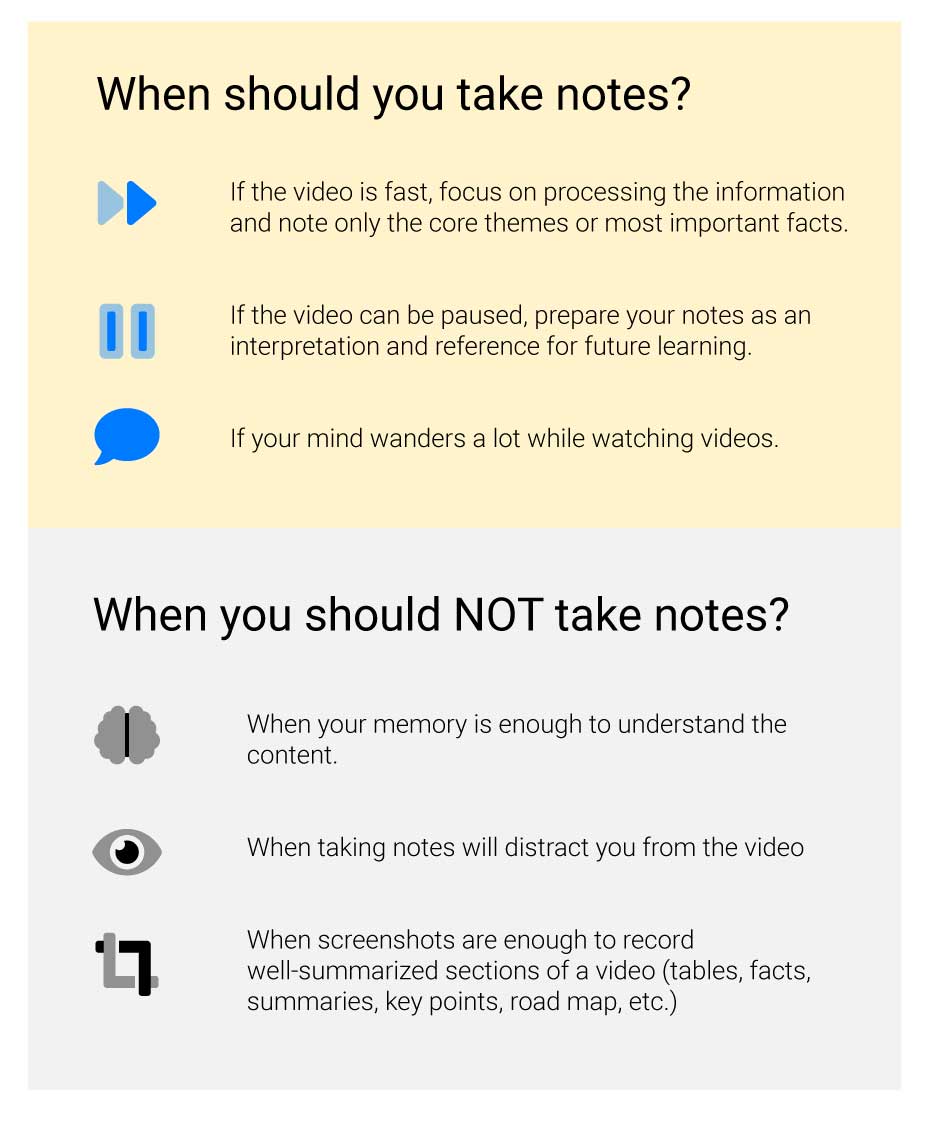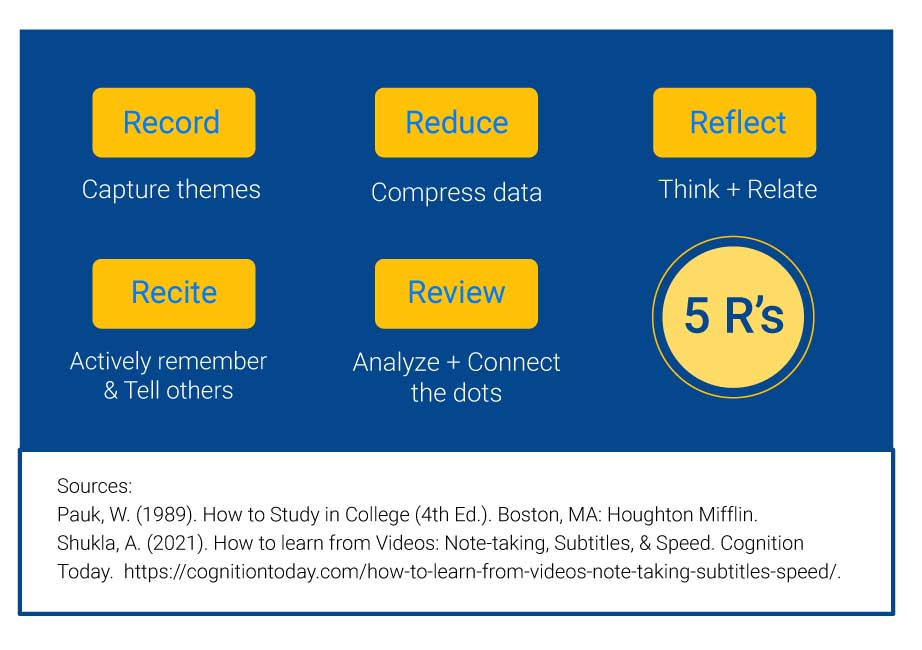
Subtitles are not just for foreign media, they compound learning via video. Sounds and letters together improve learning. And, note-taking routines help to process information more elaborately, further amplifying learning. Here’s why employee learning and internal communications improve with subs and notes.
“Can you hear me?” is now an inside joke for all working professionals who did the digital migration during lockdowns. We almost forgot about text and did everything over video. Why join a video when you could’ve sent a WhatsApp or an email? Well, video proved its value in giving communication a personal touch, with more feedback and liveliness than text could offer. But the value of text – independence from time and portability – can’t be forgotten. Is there a trade-off between video communication and text communication? Yes, but there needn’t be. The text-video power combo lies in note-taking and subtitles.
In this article, we’ll explore the value of using subtitles and note-taking to improve the power of videos in employee training and briefing.
- Subtitles: That thing which we turn on on Netflix when we are planning to stay distracted on our phones while watching something that needs more attention.
- Note-taking: That thing which we avoid because it feels like homework, even though it’s work from home.
1. Use subtitles whenever possible.
Research shows that subtitles improve memory and comprehension dramatically for all kinds of learners – young and old, slow and fast. Auditory information from talking, visual-semantic information from reading subtitles, and visual presentation information from the main video is a powerful combination. All 3 presented together cohesively are better for learning in most cases because subtitles:
- Promote comprehension.
- Capture attention.
- Allow seeing a word when one doesn’t hear a word.
- Combine auditory and visual signals for a word/sentence/concept – strengthens memory for the word/sentence/concept through deeper and elaborate processing.
- Allow some flexibility in reading ahead of spoken content.
2 Signals together (audio + subs) are better than just audio or just subs for learning.
Subtitles ensure that auditory information is encoded in the brain with 2 inputs (auditory + visual semantic components) instead of just 1 ( only auditory semantic component). 2 signals improve processing and provide more “raw material” to the brain that enhances comprehension and memory. Although subtitles feel like distractions, research shows they aren’t. Subtitles become a habit and do not distract the listener when timed and displayed appropriately. When 2 signals – audio & subtitles match, the brain improves processing for audio & subtitles independently. That makes the information in those signals more salient, more pronounced. Researchers call this the redundant signals effect. In short, subtitles improve listening, and listening improves reading subtitles. That ultimately makes both listening and reading subtitles together more effective than just listening or just reading subs.
How to use subtitles for efficient employee learning:
- Make sure your video software supports subs and are clearly visible.
- Let the presenter know people will read subs. This might improve learning for information-dense dialogs.
- Create single transcripts for the entire video presentation.
- Reduce redundancy in presentations and increase it with the subtitles on 3 levels.
- The first level: Spoken words
- Second level: Subtitles
- Third level: Highlights in presentation.
What if you are an auditory or kinesthetic learner and not visual?
A common notion is that people have are auditory, visual, or kinesthetic learners – the 3 modes of learning are called “learning styles.” Many employees believe they are either auditory learners – better learning through talking or audiobooks, or visual learners – better learning through videos and text, or kinesthetic learners – better learning through experiences or play. This belief is intuitive for many, but it doesn’t mean they learn better through their preferred learning style. Even for employees who believe they are auditory but not visual learners, displaying information in an audio and visual format with subtitles improves learning – as expected for any learner with any learning style.
The meshing hypothesis, which states that auditory learners learn better through auditory content or visual learners learn better through visual content, is not supported by evidence. Research shows learning styles do not have a meaningful impact on learning. According to many studies, the concept of learning styles is invalid. While employees have their preferred formats for learning, their preference does not affect how effective the learning material is. One explanation for this is that learners’ beliefs about their learning style affect their “judgments of learning” more than actual learning. Judgments of learning (feeling good or bad about the quality of learning) affect confidence which could affect performance and application.
Subtitles make learning holistic
Neglecting subtitles in a video might be a missed opportunity to grasp nuances. It’s also a missed opportunity to combine written words with spoken words for the most important themes in training. The combination of a word’s structure and sound is needed for current learning to connect to related information presented in diverse forms – spoken by someone else, presented in slides, spotted on Instagram, etc. This is done by the brain’s perceptual recognition system which has one primary job – recognize previous learning in the form it was learned.
It is easier to focus on keywords because combining words and audio magnify the sensory input making them stand out more. This signal includes details like the pitch of speaking, the emphasis, intonation of the speaker, pauses, visual imagery, etc., These keywords develop gravity that pulls more details together – around which one can learn better.
2. Let employees take notes, and make videos that allow note-taking
Note-taking carries a lot of hype with dedicated apps and “systems of note-taking.” These systems tell you what to focus on and how to format it. However,the benefits may not come from which app or system one uses. Instead, they come mainly from the content in notes, reduced mind-wandering, and the effort to rehearse the information.

Note-taking reduces mind-wandering
In a 2021 study, researchers compared 3 types of note-takers – those who took handwritten “longhand” notes, photos of video lectures, and no notes. Longhand note-takers performed best on a memory test even though their notes contained lesser information than those who reviewed photos of lectures. The study answered why handwritten note-takers did better than photo-takers and no-note-takers. The researchers say mind-wandering affects the relationship between learning and memory while taking notes. Note-taking reduces mind-wandering, which increases attention to the information and therefore improves learning. Writing down notes minimizes the number of random distracting thoughts that pop into the mind because the brain is fully engaged in taking notes and listening. Other research clearly shows that mind-wandering increases when attention toward a specific goal decreases – that is why the mind wanders when we do mindless habitual or routine activities or are bored. This also means that someone who has a high capacity to concentrate and pay attention doesn’t need to take notes because they will have lesser mind-wandering. All of their brain’s attention might translate into improved memory just by listening carefully.
Note-taking effort improves learning
Even while taking notes, the effort put into the notes may improve how much attention is paid to the information. Convenient notes which are extremely easy to access may actually worsen memory for 2 reasons:
- We remember where information is more than what it is in the digital world. That’s called the google effect. If we know that the information is recorded in an app or a photo, we are likely to remember only how to access that information and not the content.
- Information that is processed very shallowly leads to weak learning. Elaborative rehearsal or deep encoding is a well-documented phenomenon where deeper or elaborate/effortful processing leads to better memory. Shallow encoding is usually quickly forgotten.
Repetition of important content improves memory and familiarity, which makes it intuitive even without much immediate understanding.

What to write: Concrete details or general themes/concepts?
Notes can be a way to capture details and broad themes/concepts. Details are associated with concrete/narrow learning, and themes/concepts are related to abstract/global learning. The brain uses 2 modes of thinking: Narrow and broad/global processing, also called concrete and abstract processing.
- Narrow processing looks at concrete details like facts, properties, etc.
- Global processing looks at abstract or broad details like concepts, relations, etc.
In a web of information currently being processed by the brain, details are easily brought into awareness by other details. And global themes are easily brought into awareness by other global themes. This principle of cognitive processing is called the “construal level theory.” It states that paying attention to details (low construal) starts narrow, detail-oriented processing for other related tasks. And paying attention to the essence (high construal) of a topic starts a global, context-oriented way of thinking. For example, thinking of a phone as a “communication device” is high construal thinking, but stating its model number is low construal thinking. The “superordinate” category of a communication device makes thinking about other superordinate categories like electronics or radio waves easy and subordinate details like model numbers or specific devices makes thinking about features easy.
High construal level thinking is big-picture, global, abstract, or contextual thinking. Low construal level thinking is detail-oriented, narrow, concrete/factual, and targeted thinking. Both construal levels are important for holistic learning.
Low construal notes are – clean, factual, technical words, cover all ideas and nuances. The focus is on precision. Lists of properties, compare/contrast, names, definitions, etc., are low construal notes.
High construal notes are – scribbled, interpretative, diagram-oriented, capture the central themes and relationships. Connections between ideas, indexes, maps, mindmaps, questions to the self, prompts and reflections about training material, etc., are high construal notes.
So you can defend your shabby notes; clean notes are not necessarily superior for learning, maybe just for re-reading. But for that, you have blogs and books, and videos. :,)
Low construal notes (focusing on nuances) should promote memory for details and deductive thinking. High construal notes (focusing on the big picture) should promote memory for large relationships among ideas and abstract/creative thinking.
Handwritten or laptop and phone notes?
A study saying handwritten notes is better for conceptual understanding than typed notes influenced a lot of note-taking articles online. The study suggests that laptop note-takers do not process information deep enough to translate it into better learning. According to the study, laptop note-takers but not longhand note-takers note down a lecturer’s words as they are instead of reframing and processing that information.
However, direct replication of that study suggests the problem is not laptop or handwritten notes per se. The replication, which also analyzed 8 other studies, suggests a high word count improves learning (probably indirectly through more keywords, more attention, and deeper processing) and verbatim notes worsen learning (probably indirectly through shallow processing and mental copy-pasting).
Chances are handwritten notes and digital notes are likely to have similar effects on learning and may differ based on convenience, logistics, ability to type or write fast enough, and how & what notes are created.
Note-taking style is less important than the process of taking notes.
All styles of notes are helpful because they follow the “production effect.” The effect describes how memory for information produced by our active senses (auditory – voice, touch – writing/typing) is remembered better than information passively absorbed through our ears and eyes. Researchers also call this “generative learning” – information generated through your body and mind is learned better, especially when connected to already learned information.
Mindmaps or knowledge maps are useful ways to take notes too. They help conceptual understanding. Research shows that these maps, called graphic organizers, are helpful assets while learning. If there aren’t any notes provided with the training, making them would help the training process.
Whether they are hand-written or typed or drawn, all formats of note-taking will increase the production effect and generative learning to some extent. YMMV.
Build notes together after the training.
A 10-week assessment of online learning on 273 STEM students found those who collaboratively build a complete set of notes outperform those who collaborate but don’t build a complete set of notes. The study suggests that group note-taking to the point the notes are complete and cover all important details with every learner making some contribution can improve learning. So learners in one training session can maintain one single document to study from, which is built from compiling everyone’s notes and cleaning up repeated information. The application for workplace learning is even more powerful – an organization is inherently collaborative with people bringing in specialized skills, workflows, and perspectives to serve one goal. Collaborative note-taking with the addition of collating notes can be a powerful training tool. Trainers can also integrate employee-designed notes into the video app or training package for future learning or recertification.


